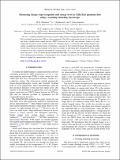Measuring charge trap occupation and energy level in CdSe/ZnS quantum dots using a scanning tunneling microscope
Author(s)
Bulovic, Vladimir; Anikeeva, Polina Olegovna; Panzer, Matthew J.; Wood, Vanessa Claire; Hummon, M. R.; Stollenwerk, A. J.; Narayanamurti, V.; ... Show more Show less
DownloadHummon-2010-Measuring charge tra.pdf (732.2Kb)
PUBLISHER_POLICY
Publisher Policy
Article is made available in accordance with the publisher's policy and may be subject to US copyright law. Please refer to the publisher's site for terms of use.
Terms of use
Metadata
Show full item recordAbstract
We use a scanning tunneling microscope to probe single-electron charging phenomena in individual CdSe/ZnS (core/shell) quantum dots (QDs) at room temperature. The QDs are deposited on top of a bare Au thin film and form a double-barrier tunnel junction (DBTJ) between the tip, QD, and substrate. Analysis of room-temperature hysteresis in the current-voltage (IV) tunneling spectra, is consistent with trapped charge(s) presenting an additional potential barrier to tunneling, a measure of the Coulomb blockade. The paper describes the first direct electrical measurement of the trap-state energy on individual QDs. Manipulation of the charge occupation of the QD, verified by measuring the charging energy, (61.4±2.4) meV, and analysis of the DBTJ, show trap states ∼1.09 eV below the QD conduction-band edge. In addition, the detrapping time, a measure of the tunneling barrier thickness, is determined to have an upper time limit of 250 ms. We hypothesize that the charge is trapped in a quantum-dot surface state.
Date issued
2010-03Department
Massachusetts Institute of Technology. Department of Electrical Engineering and Computer Science; Massachusetts Institute of Technology. Research Laboratory of Electronics; Massachusetts Institute of Technology. Research Laboratory of ElectronicsJournal
Physical Review B
Publisher
American Physical Society
Citation
Hummon, M. R. et al. “Measuring charge trap occupation and energy level in CdSe/ZnS quantum dots using a scanning tunneling microscope.” Physical Review B 81.11 (2010): 115439. © 2010 The American Physical Society.
Version: Final published version
ISSN
1098-0121
1550-235X